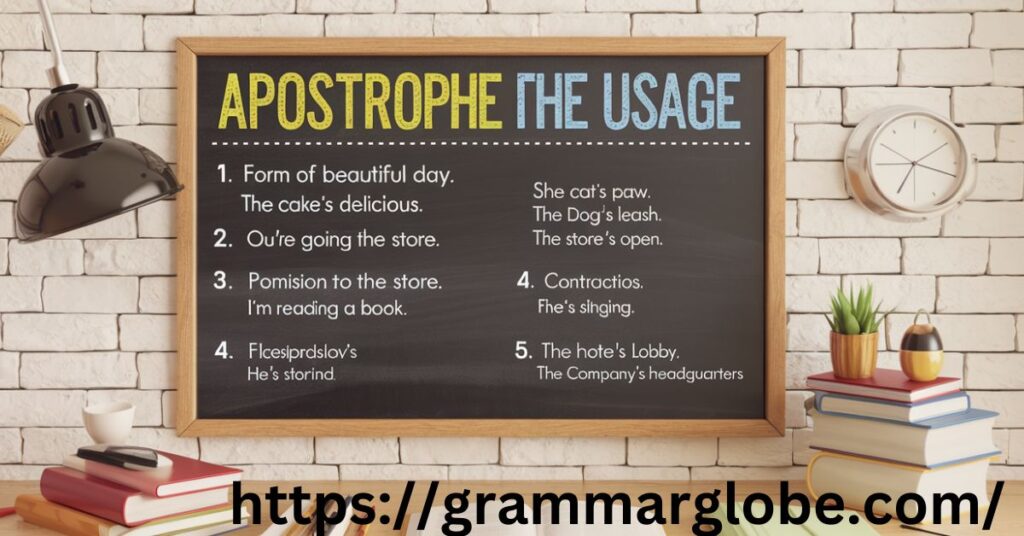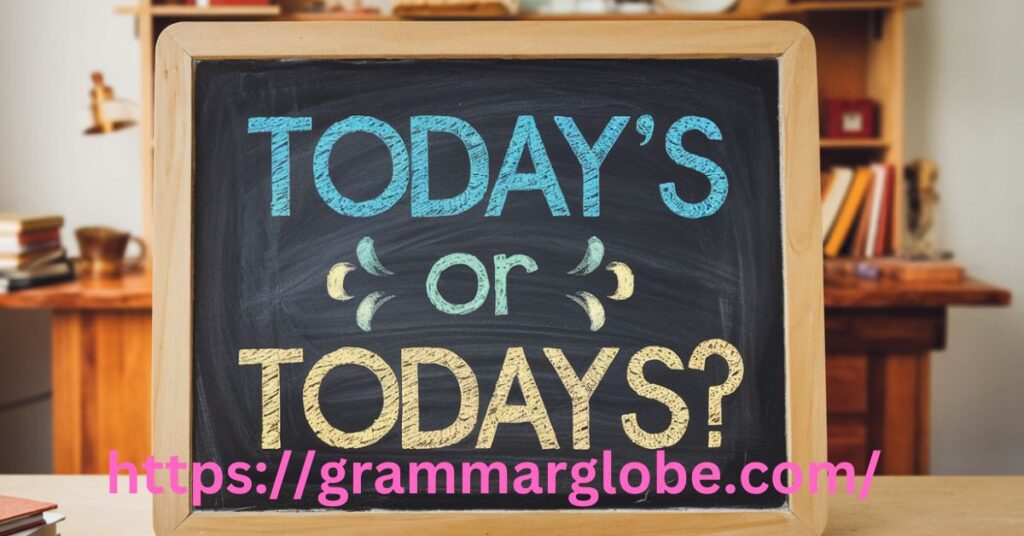Grammar is a cornerstone of effective communication, but it can also be one of its biggest stumbling blocks. A common area of confusion lies in understanding the proper use of apostrophes, especially in terms like today’s and todays. While they might seem trivial, mastering these distinctions ensures clear, professional, and impactful writing.
This article dives deep into the apostrophe mystery, exploring the rules, real-world applications, and common errors surrounding these terms. By the end of this guide, you’ll not only understand when to use today’s and avoid todays but also gain valuable insights into how proper grammar affects communication in various contexts.
Understanding Apostrophes
Apostrophes may seem small and insignificant, but their role in English grammar is anything but minor. They’re essential for conveying meaning in writing, whether you’re clarifying ownership or forming contractions. Misusing or omitting them can lead to misunderstandings and detract from the professionalism of your communication.
This section dives into the core principles of apostrophe usage, helping you navigate this punctuation mark with confidence.
What Is an Apostrophe?
An apostrophe (‘) is a punctuation mark used primarily for two purposes:
- Indicating possession: To show that something belongs to someone or something.
- Forming contractions: To combine words by replacing omitted letters.
Despite its simplicity, the apostrophe is often misunderstood and misapplied. Let’s explore its uses in more detail.
Apostrophe Usage: Key Rules

1. Indicating Possession
Possession means that something belongs to a noun. The apostrophe shows this relationship clearly.
Singular Possessive
When a singular noun owns something, you add an apostrophe followed by the letter “s.”
Examples:
- The cat’s toy (the toy belongs to the cat).
- John’s car (the car belongs to John).
Plural Possessive
For plural nouns ending in “s,” place the apostrophe after the “s.”
Examples:
- The teachers’ lounge (the lounge belongs to multiple teachers).
- The dogs’ kennel (the kennel belongs to multiple dogs).
If the plural noun does not end in “s,” add an apostrophe + “s.”
Examples:
- The children’s playground (the playground
Today’s: The Singular Possessive
When to Use Today’s
The possessive form is used when you want to show that something belongs to or is associated with today.
Examples of Correct Usage:
- Schedules: “Today’s agenda includes three key meetings.”
- Trends/News: “Today’s headlines are focused on climate change.”
- Weather Reports: “Today’s forecast predicts heavy rainfall.”
Key Contexts for Today’s
| Context | Examples |
|---|---|
| Business | “Today’s sales report highlights key metrics.” |
| Education | “Today’s lecture will cover renewable energy.” |
| Social Media | “What are today’s trending hashtags?” |
In these cases, the apostrophe in today’s signals that the subject (e.g., agenda, sales report, lecture) belongs to the present day.
Todays: The Nonexistent Plural
Unlike regular nouns that can easily form a plural by adding an “s” (e.g., dogs, books), temporal nouns like today are rarely pluralized in English. As such, todays isn’t a grammatically correct word in most contexts.
Why “Todays” Is Incorrect
If you’re tempted to use todays, pause and ask yourself:
- Am I referring to ownership? If yes, use today’s.
- Am I discussing multiple days? If so, rephrase with words like days or each day.
Examples of Misuse:
- Incorrect: “Todays meeting is canceled.”
- Correct: “Today’s meeting is canceled.”
- Incorrect: “The last two todays were hectic.”
- Correct: “The last two days were hectic.”
Exceptions:
There are rare cases where todays might appear, but they are not reflective of standard grammar rules:
- Brand Names: Companies or products might use todays as a stylistic choice (e.g., Todays Electronics).
- Typos or Errors: Writers might mistakenly use todays when they mean today’s.
Real-World Scenarios: When to Use Today’s

Recognizing when and where to use today’s can help you avoid errors and communicate more effectively.
In Business Writing
Professional emails, reports, and presentations often require clarity and precision. Using today’s correctly conveys ownership.
- Example: “Today’s report provides insight into market trends.”
In Journalism and Social Media
Headlines frequently use today’s to highlight events tied to the current day.
- Example: “Today’s top stories include advancements in AI technology.”
In Education and Academic Writing
Whether in essays, lecture notes, or classroom discussions, today’s often appears to describe the content or activities of the day.
- Example: “Today’s discussion focuses on English grammar.”
Common Mistakes and How to Fix Them
Mistakes with today’s and todays are surprisingly common, even among experienced writers. Here are the most frequent errors and how to avoid them:
Mistake 1: Using “Todays” for Possession
- Incorrect: “Todays schedule is full of meetings.”
- Correct: “Today’s schedule is full of meetings.”
- Why It’s Wrong: Possession requires an apostrophe (today’s), while todays is meaningless.
Mistake 2: Omitting the Apostrophe in “Today’s”
- Incorrect: “Todays event will start at 10 AM.”
- Correct: “Today’s event will start at 10 AM.”
- Why It’s Wrong: Without the apostrophe, the sentence lacks proper grammar, making it unclear.
3: Using “Todays” for Multiple Days
- Incorrect: “The last two todays were exhausting.”
- Correct Alternatives:
- “The last two days were exhausting.”
- “Each day’s schedule was packed.”
Pro Tip:
If you’re unsure, replace todays with today’s or rephrase to clarify meaning.
Broader Context: todays or todays Possessives in English Grammar

Possessives are used to show ownership or association in English. The structure and usage of possessives vary depending on the form of the noun (singular, plural, or irregular). Here’s a detailed breakdown:
1. Singular Nouns
For singular nouns, the possessive is formed by adding ’s to the end of the word.
- Examples:
- The cat’s whiskers (the whiskers of the cat).
- Today’s agenda (the agenda of today).
- The book’s cover (the cover of the book).
2. Plural Nouns Ending in -S
For plural nouns that already end in -s, the possessive is formed by adding only an apostrophe (’).
- Examples:
- The students’ homework (the homework of the students).
- The dogs’ kennel (the kennel for the dogs).
- The bosses’ decisions (the decisions of the bosses).
3. Irregular Plural Nouns
Irregular plural nouns that do not end in -s form the possessive by adding ’s just like singular nouns.
- Examples:
- The children’s toys (the toys of the children).
- The men’s room (the room for men).
- The geese’s migration (the migration of the geese).
4. Compound Nouns
For compound nouns, the possessive is applied to the last word of the compound structure.
- Examples:
- My sister-in-law’s car (the car of my sister-in-law).
- The commander-in-chief’s orders (the orders of the commander-in-chief).
5. Joint Possession
When two or more nouns share ownership, only the last noun takes the possessive form.
- Examples:
- Jack and Jill’s pail (the pail belongs to both Jack and Jill).
- Mary and Tom’s house (the house is owned by Mary and Tom together).
6. Separate Possession
When two or more nouns have separate ownership, each noun takes the possessive form.
- Examples:
- Jack’s and Jill’s books (Jack has books, and Jill has different books).
- Mary’s and Tom’s ideas (Mary has ideas, and Tom has distinct ideas).
General Rules for Clarity and Style
- Pronunciation Tip:
Adding ’s to singular nouns ending in -s (e.g., boss’s) is standard but optional in some style guides. - Example: The boss’s decision or the boss’ decision.
- Avoid Overusing Apostrophes:
Don’t use an apostrophe for plurals unless they are possessive. - Correct: The Smiths’ house (the house of the Smith family).
- Incorrect: The Smith’s house (incorrect use for the plural).
- For Non-Living Things:
Some style guides discourage using possessives for inanimate objects. Use “of” instead. - Preferred: The door of the car.
- Acceptable: The car’s door.
Possessives Beyond Grammar
Understanding possessives goes beyond grammar; it enhances communication by ensuring clarity and precision. Proper usage is vital in:
- Professional Writing: E.g., Reports, proposals, and correspondence.
- Creative Writing: To convey nuanced meanings.
- Everyday Speech: For effective and clear conversation.
- SEO Writing: Correct possessive usage improves readability and professional appeal.
Mastering possessives in English demonstrates a solid grasp of the language and enhances both written and spoken communication.
Possessive vs. Plural: A Comparison
| Word | Singular Possessive | Plural Possessive |
|---|---|---|
| Day | Day’s | Days’ |
| Yesterday | Yesterday’s | N/A |
| Tomorrow | Tomorrow’s | N/A |
Key Takeaway:
Temporal nouns rarely form plurals. Instead, their possessive forms signal ownership or association.
Practical Tips for Mastering Apostrophe Usage todays or todays

To avoid errors, follow these practical tips:
Quick Checklist
- Identify Ownership: If the noun belongs to something, add an apostrophe.
- Check Context: Is it singular or plural? Adjust the form accordingly.
- Proofread Carefully: Even seasoned writers make apostrophe errors. Tools like Grammarly can help.
Apostrophe Rules Simplified
| Scenario | Example |
|---|---|
| Singular Possessive | “Today’s meeting is at 2 PM.” |
| Plural Possessive | “The days’ events were well-organized.” |
| Avoiding Pluralization of Today | “The last two days were hectic.” |
Why Grammar Matters: The Impact of Proper Usage
Correct grammar isn’t just about following rules—it’s about clarity, professionalism, and credibility. Misusing todays instead of today’s can lead to confusion or even make your writing appear careless.
Professionalism and Communication
Using correct grammar enhances your reputation, especially in business, education, and journalism. As Melissa Davis, an expert in English grammar, explains:
“Proper apostrophe usage reflects attention to detail, which is critical for effective communication. Missteps with terms like today’s and todays can distract readers from your message.”
SEO and Content Quality
In digital content, grammar impacts search engine rankings. Articles with accurate grammar and optimized keywords, like “Today’s or Todays? Unraveling the Apostrophe Mystery,” perform better in search engines.
Conclusion
The difference between today’s and todays might seem small, but it’s significant. By understanding apostrophe rules and applying them correctly, you’ll avoid common mistakes and ensure clear communication.
Remember:
- Use today’s to show possession.
- Avoid todays unless it’s part of a brand name or stylistic choice.
- Proofread carefully to maintain credibility and professionalism.

Johan Michel is a clever linguist at Grammar Globe, where he dives into the nuances of English grammar and wordplay. Known for his sharp humor and insightful puns, Johan’s articles make grammar lessons both fun and accessible. Explore his unique style at https://grammarglobe.com/.






